A) where oceans are deepest,allowing for sufficient mixing.
B) along the equator where the sun's rays are most direct.
C) at the subtropics because descending air promotes clear skies.
D) at the poles where long days during the summer warm the water.
Correct Answer

verified
Correct Answer
verified
Multiple Choice
In regard to the Southern Oscillation,when
A) pressures are low in Darwin,pressures are also lower in Tahiti.
B) pressures are high in Tahiti,pressures are also high in Darwin.
C) pressures are high in Darwin,pressures are lower in Tahiti.
Correct Answer

verified
Correct Answer
verified
Multiple Choice
The El Niño begins to weaken and eventually terminates when
A) the leading edge of the cold Kelvin wave finally reaches the eastern coast of South America.
B) cold water spreads out away from the equator,bringing warm upwelling waters from depth.
C) cold water converges on the equator,bringing cold upwelling waters from depth.
D) warm water spreads out away from the equator,bringing cold upwelling waters from depth.
Correct Answer

verified
Correct Answer
verified
Multiple Choice
This image shows the hypothetical planet in the investigation for the ocean interactions chapter.Where is the most likely location of a warm pool? 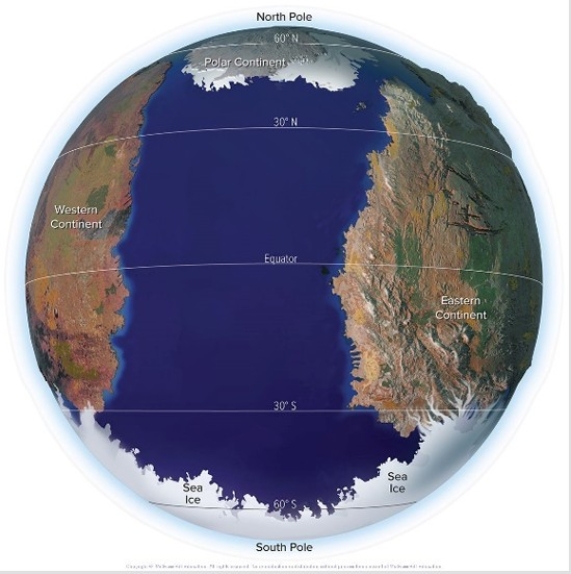
A) At 45° N in the Northern Hemisphere
B) At 45° S in the Southern Hemisphere
C) Along the equator of the Western Continent
D) Near the center of the Eastern Continent
Correct Answer

verified
Correct Answer
verified
Multiple Choice
The term "El Niño" phenomena in December in Peru explains
A) warming of an otherwise cold current,which brings heavy rain and flooding.
B) cooling of an otherwise cold current,which brings heavy rain and flooding.
C) warming of an otherwise cold current,which brings high temperatures and drought.
D) cooling of an otherwise warm current,which brings high temperatures and drought.
Correct Answer

verified
Correct Answer
verified
Multiple Choice
The thermocline would be expected to be closest to the surface off the western coast of south America during
A) neutral ENSO.
B) La Niña.
C) El Niño.
D) La Niña and El Niño.
Correct Answer

verified
Correct Answer
verified
Multiple Choice
Which of the following letters best represents a location where sinking air in a Walker cell is most typical? 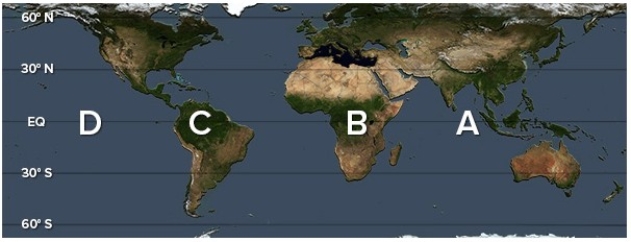
A) A
B) B
C) C
D) D
Correct Answer

verified
Correct Answer
verified
Multiple Choice
A strong negative index for the North Atlantic Oscillation (NAO) usually means there is ________ of a pressure difference between the Bermuda (subtropical) High and the Icelandic Low pressure.This brings ________ than average temperatures over the northern U.S.and Northwest Europe.
A) less; cooler
B) less; warmer
C) greater; cooler
D) greater; warmer
Correct Answer

verified
Correct Answer
verified
Multiple Choice
Which of the following locations would be characterized by drier and warmer conditions during a La Niña? 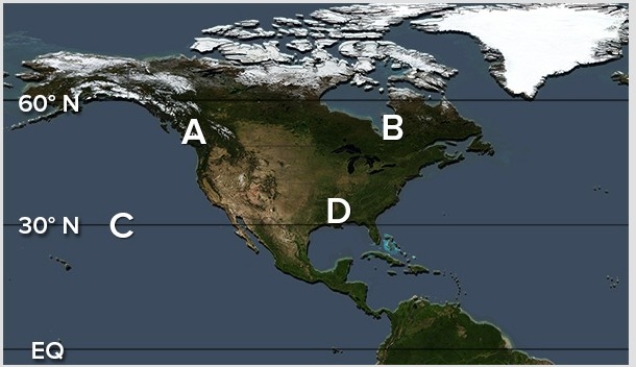
A) A
B) B
C) C
D) D
Correct Answer

verified
Correct Answer
verified
Multiple Choice
A positive phase of the Indian Ocean Dipole (IOD) results in warmer than average surface waters at ________ and cooler than average waters at ________. 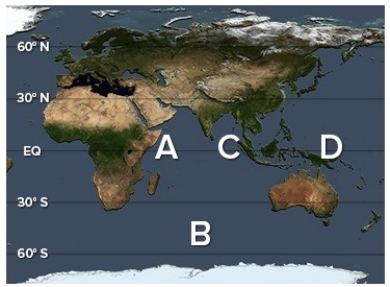
A) A; C
B) A; D
C) C; A
D) C; B
Correct Answer

verified
Correct Answer
verified
Multiple Choice
Decreasing salinities and lower density,water near the equator is due to
A) stable conditions creating abundant rain.
B) unstable conditions creating abundant rain.
C) upwelling conditions created by highly saline surface waters.
D) upwelling conditions created by freshwater surface waters.
Correct Answer

verified
Correct Answer
verified
Multiple Choice
This image shows the hypothetical planet in the investigation for the ocean interactions chapter.What type of prevailing winds are most likely between the equator and 30° N? 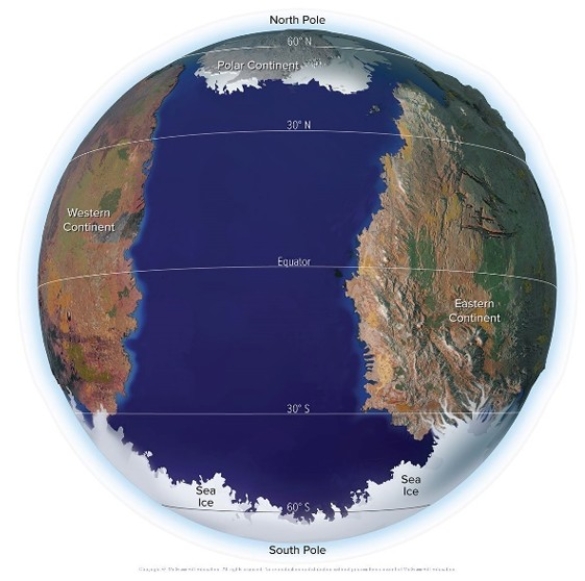
A) Trade winds
B) Westerlies
C) Polar easterlies
D) No winds
Correct Answer

verified
Correct Answer
verified
Multiple Choice
In January,the Intertropical Convergence Zone is shifted to
A) the north of the Isthmus,and winds blow across the Isthmus,from the northeast.
B) the north of the Isthmus,and winds blow across the Isthmus,from the southwest.
C) the south of the Isthmus,and winds blow across the Isthmus,from the southwest.
D) the south of the Isthmus,and winds blow across the Isthmus,from the northeast.
Correct Answer

verified
Correct Answer
verified
Multiple Choice
Which of the following is NOT influenced by the Pacific Decadal Oscillation (PDO) ?
A) Sea-surface temperatures
B) Wind directions and strengths
C) Populations of salmon
D) Lengths of glaciers
E) All of these choices are correct
Correct Answer

verified
Correct Answer
verified
Multiple Choice
Which of the following locations is associated with a zone of upwelling for the Antarctic bottom waters (AABW) ? 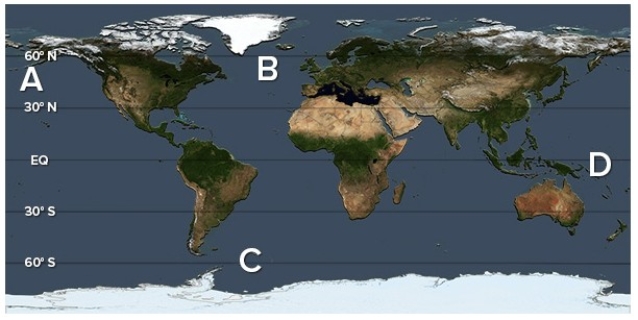
A) A
B) B
C) C
D) D
Correct Answer

verified
Correct Answer
verified
Multiple Choice
El Niño would bring the warm pool and associated convective rainfall to 
A) A.
B) B.
C) C.
D) D.
Correct Answer

verified
Correct Answer
verified
Multiple Choice
A Kelvin wave develops when:
A) westward moving winds weaken,causing the mound of warm water in the western Pacific to move eastward.
B) eastward moving winds weaken,causing the mound of warm water in the western Pacific to move eastward.
C) westward moving winds strengthen,causing the mound of warm water in the western Pacific to move eastward.
D) westward moving winds weaken,causing the mound of warm water in the western Pacific to move westward.
Correct Answer

verified
Correct Answer
verified
Multiple Choice
During the warm phase of the El Niño,the ITC is drawn south and west of its normal position.This has the effect of
A) weakening the orographic effect on the Caribbean side of the Isthmus.
B) warming the waters on the Caribbean side of the Isthmus.
C) weakening the rain-shadow effect on the Pacific side of the Isthmus.
D) enhancing the rain-shadow effect on the Pacific side of the Isthmus.
Correct Answer

verified
Correct Answer
verified
Multiple Choice
Which of the following locations would be characterized by warmer conditions than during an El Niño? 
A) A
B) B
C) C
D) D
Correct Answer

verified
Correct Answer
verified
Multiple Choice
The air above this current is characterized by extremely strong pressure gradients and relative lack of land interruptions that induce extremely strong westerly winds.
A) California Current
B) Gulf Stream
C) Antarctic Circumpolar Current
D) North Equatorial Current
Correct Answer

verified
Correct Answer
verified
Showing 41 - 60 of 93
Related Exams